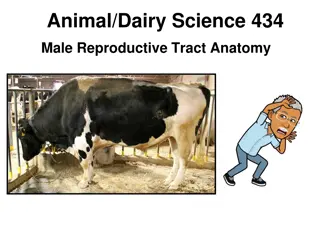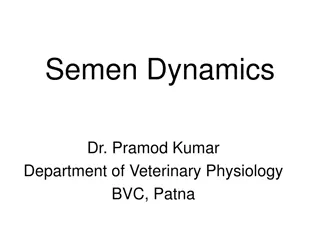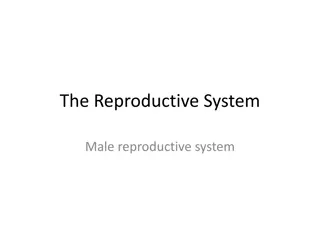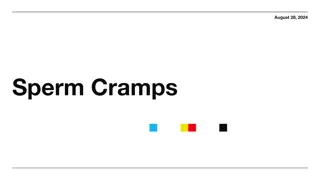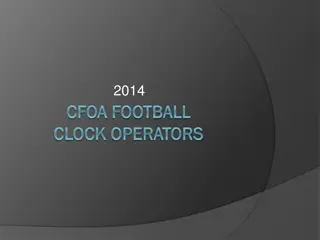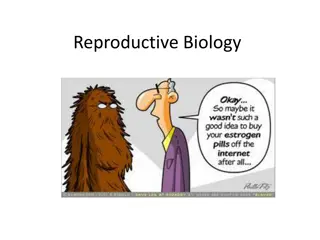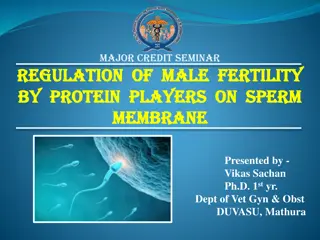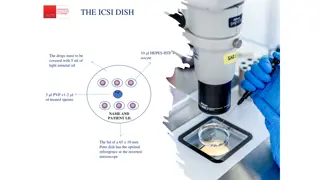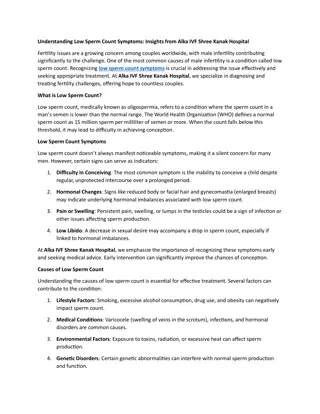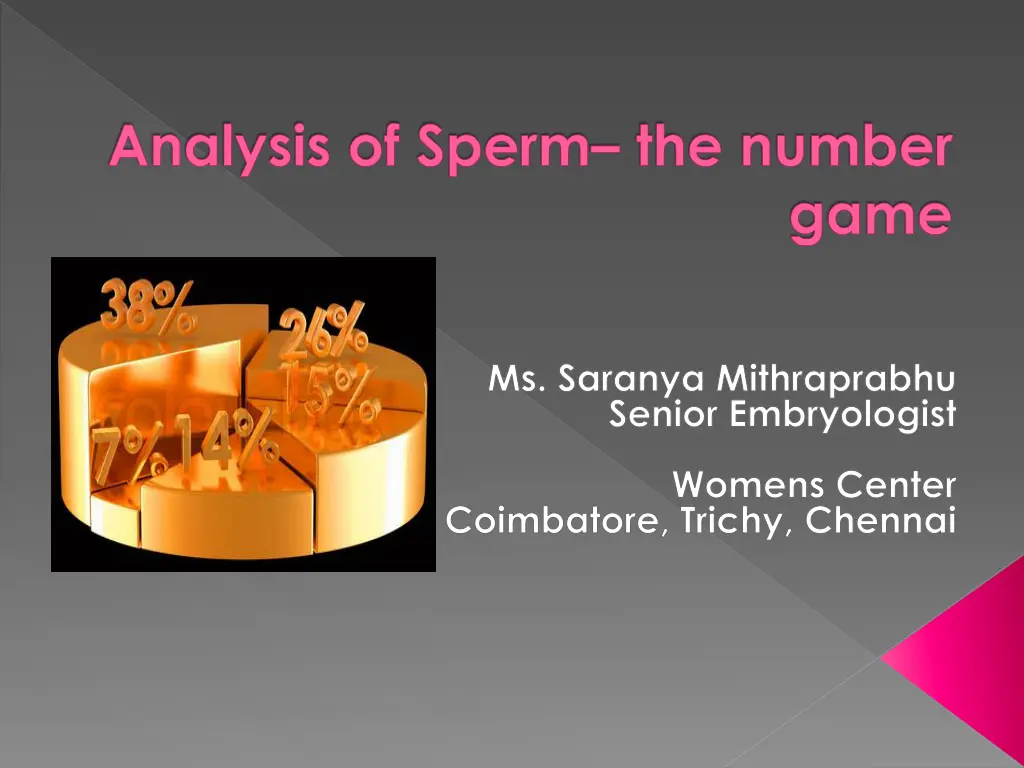
Understanding Sperm Analysis and Male Fertility
Explore the latest WHO standards and assessments in sperm analysis, including morphology evaluation, motility grading, and predictive assessments for male fertility potential. Learn about the importance of sperm biomarkers and tests beyond routine sperm analysis in assisted reproductive techniques.
Download Presentation

Please find below an Image/Link to download the presentation.
The content on the website is provided AS IS for your information and personal use only. It may not be sold, licensed, or shared on other websites without obtaining consent from the author. If you encounter any issues during the download, it is possible that the publisher has removed the file from their server.
You are allowed to download the files provided on this website for personal or commercial use, subject to the condition that they are used lawfully. All files are the property of their respective owners.
The content on the website is provided AS IS for your information and personal use only. It may not be sold, licensed, or shared on other websites without obtaining consent from the author.
E N D
Presentation Transcript
Analysis of Sperm the number game Ms. Saranya Mithraprabhu Senior Embryologist Womens Center Coimbatore, Trichy, Chennai
What are we looking at Sperm analysis New WHO standards Genetics of male infertility Sperm Biomarkers tests beyond routine sperm analysis Assisted Reproductive Techniques
Cut-off values for Semen parameters as published in consecutive WHO manuals Semen parameters WHO 1980 WHO 1987 WHO 1992 WHO 1999 WHO 2010 ---- > or = 2 > or = 2 > or = 2 1.5 Volume (ml) 20-200 > or = 20 > or = 20 > or = 20 15 Conc. ----- > or = 40 > or = 40 > or = 40 39 Total conc. > or = 60 > or = 50 > or = 50 > or = 50 40 Total motility > or = 2 > or = 25% > or = 25% (a) > or = 75 > or = 25% (a) > or = 75 32% (a+b) PR motility ---- > or = 50 58 Vitality (%) 80.5 > or = 50 > or = 30 14 4 Morphology <4.7 <1.0 <1.0 <1.0 <1.0 Leukocyte
Sperm Analysis WHO, 5thedition, 2010 Sperm conc. Total motility Progressive motility Vitality Morphology 15 M/ml 40% 32% (a+b) 58% 4% Abnormal results WHO 1999 reclassified as Normal results WHO 2010
Motility grading WHO 5thedition, 2010 Progressive motility (PR) Sperm moving actively, regardless of speed Non progressive motility (NP) Absence of progression Immotile (IM) No movement Motility grading as a,b,c,d in WHO 4th edition changed to PR, NP and IM in WHO 5th edition
Sperm morphology - assessments Kruger strict criteria for morphology evaluation Shape of sperm Acrosome (40% - 70% of sperm head) Only specialized andrology laboratories can perform strict evaluation Stained sperm (size, head shape, mid piece, tail and other abnormalities) are examined under oil at 100X power
Sperm function predictive assessments Total motile sperm count Sperm no. in the entire ejaculate Total functional motile sperm count No. of functionally competent sperm Teratozoospermic Index No. of abnormalities present per abnormal spermatozoon Sperm deformity Index Multiple structural deformities Critical to assess the male fertility potential
Functional motile sperm count - Interpretation Procedure Ranges (per ejaculate) IUI 5 10 M/ejaculate IVF >0.3 M/ejaculate ICSI <0.3 M/ejaculate No. of functionally competent sperm
Teratozoopsermic Index- Interpretation Procedure Teratozoospermic Index IUI < 1.5 IVF / ICSI > 1.5 Poor fertility prognosis > or = 3.0 No. of abnormalities present per abnormal spermatozoon
Leucoscreen Excessive presence indicates reproductive tract infection Leucocytospermia This is associated with reductions in the Ejaculate volume Sperm concentration Sperm motility Loss of sperm function as a result of oxidative stress Threshold value < or = 5x106 M/ml of round cells < or = 1x106 M/ml of leucocytes Differentiates white blood cells from other round cells
Sperm analysis Basic model Jonge 2012 Reference book WHO manual Non-adherence to the standardized protocols Non-compliant laboratories generate data that may not be relevant for comparison with reference values where standardized protocols have been adhered to Sperm analysis has its own limitations
What are we looking at Sperm analysis New WHO standards Genetics of male infertility Sperm Biomarkers tests beyond routine sperm analysis Assisted Reproductive Techniques
Sperm analysis : Limitations Bungam et al., 2011 Predictive value in relation to achieving spontaneous pregnancy is poor Predictive value in relation to the choice of ART technique is limited Poor link between the pathogenesis and the diagnosis of sperm evaluation Male infertility evaluation much more than a simple sperm analysis
Genetics of male infertility Genetic etiology for reproductive failure Azoospermia Severe oligozoospermia Azoospermia Non-obstructive (Cystic Fibrosis) Obstructive (Y chromosome deletions) Karyotyping as part of pre- treatment screening for <5.0M/ml sperm concentration
Obstructive / Non-obstructive Azoopsermia Obstructive Azoospermia Congenital Bilateral Absence of Vas Deferens (CBAVD) is the common cause Spermatogenesis intact and can be retrieved from epididymis Non-obstructive Azoospermia Y chromosome deletions AZF locus contains genes for spermatogenesis AZFa, AZFb, AZFc
AZF microdeletions AZFa and AZFb deletions Spermatogenic failure (Sertoli Cell Syndrome) causing Azoospermia Testicular sperm retrieval ineffective AZFc deletions Variable phenotype mild Oligozoospermia to Azoospermia Sperm retrieval from ejaculate (for oligozoospermia) Testicular biopsy (for Azoospermia) Y chromosome deletions at a much higher rate in infertile men than in fertile controls
What are we looking at Sperm analysis New WHO standards Genetics of male infertility Sperm Biomarkers beyond routine sperm analysis Assisted Reproductive Techniques
Sperm Biomarkers Sperm analysis fails to assess the genetic material present in the sperm head which transmits into the oocyte and embryo Newer markers needed to predict pregnancy outcome and risk of adverse outcome Sperm DNA integrity better measure of fertility potential DNA fragmentation will reduce the sperm cells ability to produce a viable embryo
Role of sperm DNA reproductive outcome Fertilization involves Fusion of the cell membrane Union of the male and female gamete genomes Sperm DNA integrity plays a role in Fertilization process Embryo development Sperm DNA damage includes DNA fragmentation Abnormal chromatin packaging Protamine deficiency Ample clinical evidence to show that sperm DNA damage adversely affects reproductive outcome Sperm DNA fragmentation inversely related to the sperm cells ability to produce a viable embryo
Mechanisms of Sperm DNA fragmentation Apoptosis in Spermatogenesis DNA strand breaks during remodelling of sperm chromatin during spermiogenesis Post testicular DNA fragmentation via ROS, during sperm transport through seminiferous tubules and epididymis Induced by Endogenous caspases and endonucleases Radio and chemotherapy Environmental toxicants Smoking
Sperm DNA fragmentation - Conditions Idiopathic infertility Persistent infertility after treatment of female Recurrent miscarriage Cancer in male: before and after treatment Abnormal sperm analysis Advancing male age (>50 years)
Sperm DNA fragmentation - Evaluation Sperm Chromatin Structure Assay (SCSA) Tdt-mediated-dUTP nick end labelling (TUNEL) Single cell gel electrophoresis (COMET) Sperm Chromatin Dispersion (SCD) Acridine Orange test Toluidine Blue Test Oxidised deoxynucleoside Chromomycin A3 staining Annexin V-Binding Ability Assay Evaluation of Anti- or Pro- Apoptotic Proteins
Sperm Chromatin Structure Assay Gold standard method Major tests applied for clinical evaluation Over the last decade over 125 peer-reviewed research articles available to show the clinical relevance for DNA damage assessment
SCSA Principle Bungum et al., 2011 DNA Fragmentation Index (DFI) and % of Spermatozoa with abnormally High DNA Stainability (HDS) are calculated DFI related to Sperm with both single and double strand breaks Impairment of normal protamination HDS related to Immature spermatozoa
SCSA - Advantage Availability of a standardized protocol Adherence to the standardized protocol minimizes inter-laboratory variation Precision Flow Cytometer used measuring 1000 s of sperm rather than a 100
DNA Fragmentation Index - Interpretation DNA damage <15% - > 20% - 25 to 30% - Directly IVF/ICSI >30% - Normal sample Partly explains infertility problem ICSI to be considered
What are we looking at Sperm analysis New WHO standards Genetics of male infertility Sperm Biomarkers beyond routine sperm analysis Assisted Reproductive Techniques
IUI TFMSC and TZI Do s Dont s Total functional motile sperm count 5 to 10 M/ejaculate Total functional motile sperm count <5 M/ejaculate Teratozoospermic Index <1.5 Teratozoospermic Index >1.5 (poor fertility prognosis) IUI not to be done with severe Oligoasthenoteratozoospermic samples
IVF/ICSI TFMSC, TZI and DFI Functional motile sperm count >0.3 M/ej IVF may be considered < 0.3 M/ej ICSI to be done Acts as a predictive factor in the choice of treatment modality required Teratozoospermic Index >1.5 directly IVF/ICSI DNA Fragmentation Index 25 to 30% - directly IVF/ICSI >30% - ICSI to be considered
TESE - ICSI Diagnostic TESE Performed prior to IVF Sperm viability and morphology assessed Cryopreserved if sperm present Therapeutic TESE Performed on day of Oocyte retrieval In some cases, cryopreserved TESE also used
100% immotile sperm Immotile sperm can either be dead or live Viability status at sperm analysis using eosin nigrosin stain Hypo Osmotic Swellling Test used to select sperm during ICSI First Women s Center pregnancy with 100% immotile sperm achieved in 1999
Intracytoplasmic Morphologically selected Sperm Injection (IMSI)
Intracytoplasmic Morphologically selected Sperm Injection (IMSI) Type: JPG
Thank you Thank you Type: JPG

